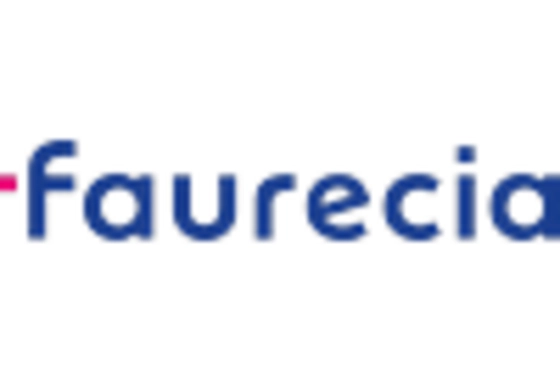The Automotive Grab Handle Market is currently characterized by a dynamic competitive landscape, driven by a confluence of innovation, strategic partnerships, and a growing emphasis on sustainability. Key players such as Denso Corporation (Japan), Magna International Inc. (Canada), and Faurecia S.A. (France) are actively shaping the market through their distinct operational focuses. Denso Corporation (Japan) emphasizes technological innovation, particularly in lightweight materials that enhance vehicle efficiency. Meanwhile, Magna International Inc. (Canada) is pursuing a strategy of regional expansion, particularly in emerging markets, to capitalize on the increasing demand for automotive components. Faurecia S.A. (France) is focusing on sustainability, integrating eco-friendly materials into their grab handle designs, which aligns with the broader industry trend towards greener manufacturing practices. Collectively, these strategies contribute to a competitive environment that is increasingly oriented towards technological advancement and environmental responsibility.
In terms of business tactics, companies are increasingly localizing manufacturing to reduce lead times and enhance supply chain resilience. This approach appears to be particularly effective in a moderately fragmented market, where the collective influence of key players is significant. The competitive structure is evolving, with major companies leveraging their The Automotive Grab Handle Market demands. This localized approach not only mitigates risks associated with global supply chain disruptions but also allows for more tailored product offerings that meet regional consumer preferences.
In August 2025, Denso Corporation (Japan) announced a partnership with a leading automotive manufacturer to develop advanced grab handles that incorporate smart technology, enhancing user experience and safety. This strategic move underscores Denso's commitment to innovation and positions the company at the forefront of the smart automotive accessories segment. By integrating technology into traditional components, Denso is likely to attract a tech-savvy consumer base, thereby enhancing its competitive edge.
In September 2025, Magna International Inc. (Canada) unveiled a new manufacturing facility in Eastern Europe, aimed at increasing production capacity for grab handles and other interior components. This expansion is strategically significant as it allows Magna to better serve the growing automotive market in the region, while also reducing transportation costs and lead times. Such investments in local manufacturing capabilities are indicative of Magna's proactive approach to meeting the evolving demands of the automotive industry.
In July 2025, Faurecia S.A. (France) launched a new line of grab handles made from recycled materials, reflecting its commitment to sustainability. This initiative not only aligns with global trends towards eco-friendly products but also positions Faurecia as a leader in sustainable automotive solutions. By prioritizing environmental considerations in product development, Faurecia is likely to enhance its brand reputation and appeal to environmentally conscious consumers.
As of October 2025, the competitive trends in the Automotive Grab Handle Market are increasingly defined by digitalization, sustainability, and the integration of artificial intelligence. Strategic alliances among key players are shaping the landscape, fostering innovation and enhancing product offerings. The shift from price-based competition to a focus on technological advancement and supply chain reliability is evident, suggesting that future competitive differentiation will hinge on the ability to innovate and adapt to changing consumer preferences.


















Leave a Comment